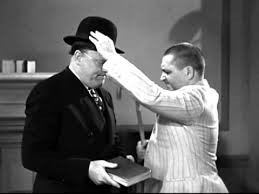 Sometimes we receive unreasonable and confusing directions, and sometimes we give them. Check out this example.
Sometimes we receive unreasonable and confusing directions, and sometimes we give them. Check out this example.
As in the short video clip, even if the systems behind this confusion are sound and the motivations reasonable, when you put them together they can create a frustrating no-win situation.
Here are a few examples from my recent experience:
At an aerospace manufacturer, I followed a team of engineers to the factory floor to observe a defect caused by what they all thought was an assembly mistake. When we arrived at the assembly workstation, the team member was ready for us. Holding an assembly drawing in one hand and a fixture instruction in the other, he asked us, “Which one these do you want me to use?” A closer examination of the two documents revealed conflicting directions. The team member continued, “If I follow the assembly drawing to the letter, the part won’t fit the fixture, but if I follow the fixture instruction exactly, the final dimensions for the part are out of spec, so I have to compromise the assembly instruction in order to make the part.” Each assembly document came from a different department and each department was adamant that its document was correct.
At a small industrial distributor, a sales order department sales associate pointed to the wall behind her desk. “All of these notes and schedules above my computer represent special deals that we have struck with particular customers. It’s hard enough to remember all of them, but sometimes I have conflicting discount offers. I may choose the wrong one, or maybe I’m supposed to combine them, but that could add up to an 80% discount in some cases.” Unfortunately the conflicting instructions often resulted in customer complaints, change orders and credits involving multiple departments.
On a broader scale, managers often grapple with conflicting goals and measures. For example, a machine shop manager whose efforts to reduce set-up times and run smaller batches whose improvement efforts are rewarded with a low machine utilization score. As Edward’s Deming put it, “You can’t sharpen the blade while the saw is running.”
I believe this can be called Muri: mental strain caused by insufficient or conflicting information. Most often this kind of Muri is internal to the organization and inadvertent because it comes from multiple authorities, each of whom feels they are doing the right thing.
Do you have examples of unreasonability in your organization you can share? What are effective countermeasures to this kind of mental Muri?
O.L.D.
P.S. Please join me tomorrow at 3:00 p.m. EST for a free, live 45-minute webinar on "3P - Production Preparation Process". You can register online here.
And don’t miss GBMP's next Shingo Institute course offerings coming up in the week of May 11 at Vibco, Inc., in Rhode Island. I'll be teaching DISCOVER Excellence on May 11 & 12 and Continuous IMPROVEMENT on May 13-14. Join us for one or both; I must admit it's very convenient to have two of the four courses under your belt in one week and I hope to see you there. Register online here.



